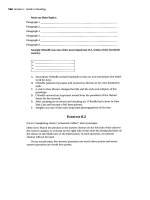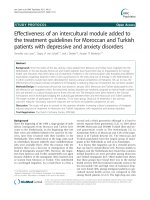Module 1-introduction to the course
Bạn đang xem bản rút gọn của tài liệu. Xem và tải ngay bản đầy đủ của tài liệu tại đây (996.51 KB, 26 trang )
Instructor: Nguyen Thi Hoai Minh, M.A in TESOL
1
Course overview
What do you expect to learn from the
course?
2
Course overview
The course provides a comprehensive overview
of the issues surrounding the teaching of young
learners:
theory and practice;
classroom techniques;
clear examples, tasks.
3
Course objectives
At the end of the course, the students will be able to:
understand the special characteristics of children as
language learners;
manage children language classes;
create, adapt and analyse activities and resources for
YL
apply theoretical background into practice of teaching
language skills.
4
Course requirement
The students have to:
attend 80% of class time
participate into class activities
bring blank paper, a pencil, a rubber, color
crayons/pencils to class
do homework assignments
5
Coursebooks
Pinter, Annamaria. 2006. Teaching Young Language
Learners. Oxford University Press.
Moon, Jayne. 2000. Children Learning English.
Macmillan Publishers Limited.
6
Course assessment
Attendance : 10%
Group teaching practice: 20%
Final exam: 70%
(true/false, multiple choice, ordering,
matching, lesson planning)
7
8
Defining a young learner
Age: 5/6 – 11/ 12 years old (Philips 1993);
Starting formal schooling
9
Characteristics of young learners
What characteristics do children bring to
class?
What do you know about how children
learn languages?
Brewster 2002, task 1, p. 13
Moon 2000, task 1, p. 2
10
Contexts for learning English
Time for learning English
Exposure to English
A real need for English
Variety of input
Meaningful input
(Moon 2000, pp. 1-2)
11
Children as language learners
Using language creatively
Going for meaning
Using chunks of the language
Having fun
Joining in the action
Talking their heads off
Feeling at home
12
Supporting young language learners
Create a real need and desire to use English
Provide sufficient time for English
Provide exposure to varied and meaningful input
Provide opportunities for language practice and use in
context
Create a friendly atmosphere
Provide feedback on learning
Help children notice the underlying patterns in language
(Moon 2000, p. 10)
13
Teaching Demonstration
(Moon 2000, p. 11)
What did I do to…
create a real need and desire to use English
provide exposure to varied and meaningful input
provide opportunities for language practice and use in
context
create a friendly atmosphere
provide feedback on learning
help children notice the underlying patterns in language
14
15
Techniques – using language
repeating pupils’ answers
rephrasing pupil’s answers
prompting through a rise in intonation
framing sentences
using gestures and actions
…
16
More techniques
activating background knowledge
giving positive feedback
creating meaningful purposes for using language
encouraging predictions
using visual reinforcement
…
17
Techniques
(Moon 2000, p. 75)
18
Demonstration
The wheels on the bus
Go round and round
Round and round
Round and round
The wheels on the bus
Go round and round
All day long
19
The driver on the bus
Turns right and left
Right and left
Right and left
The driver on the bus
Turns right and left
All day long
20
The children on the bus
Jump up and down
Up and down
Up and down
The children on the bus
Jump up and down
All day long
The driver on the bus
said,
‘move on back’
‘move on back’
‘move on back’
The driver on the bus
said,
‘move on back’
All day long
21
22
Group discussion
What factors influence
children’s attitude to
learning English?
23
24
It is not
complicated and
it is a beautiful
language.
That way I have
more culture. I
can understand
computers and
game instruction.
My English is
poor. I feel a
bit behind.
What influences children’s attitude
Teachers and teaching methods
Seeing the needs for English outside school
Parental and peer influences
Personal preferences, interest in language
25









